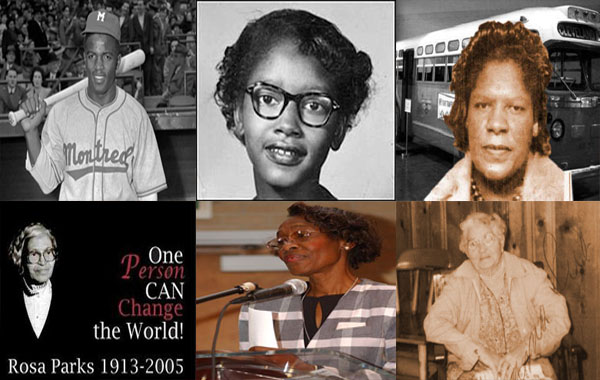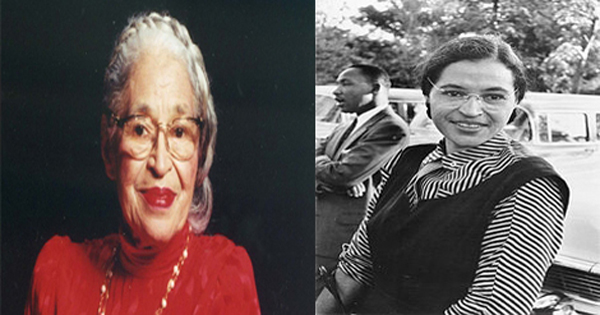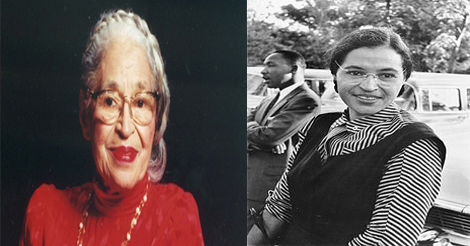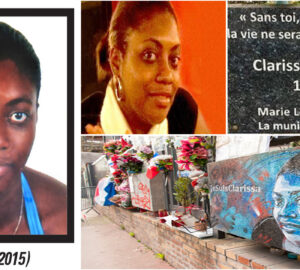Courageous: Rosa Parks said “No” to racial segregation
Segregationist laws “Jim Crow” unfair to blacks
Blacks in America lived in a non-equitable society, where the treatment reserved for the whites was not the same for blacks. Many blacks, frightened, did not disobey the rules, so as not to get into trouble. But, submission is not often the solution. Fortunately courageous people like Jackie Robinson (1944), Claudia Colvin, 15, (March 2, 1955) and Rosa Parks (1955), 42, had the courage to say “no” to racial segregation and refuse to Give up their seats.
On a daily basis, blacks faced persistent racism. In the southern United States, public fountains were also segregated. There were fountains reserved for whites, and others reserved for blacks. Whence, when she was a child, Rosa Parks thought that the water of the fountains for the Whites had a better taste than the water reserved for the Negroes.
In addition, buses and trains also suffered racial segregation. There were sections reserved for whites and others for blacks.
For example, on the Montgomery bus, the first four rows (the first 10 seats) of the bus were reserved for white passengers, and the blacks had to sit in the back. Blacks were allowed to use the central area until the whites needed it. But when a white man got on the bus, blacks automatically had to give way. Even more humiliating, if the squares were occupied, blacks had to buy a ticket at the front, but were forced out, before returning again through the back door of the bus, to access their seats.
Rosa Parks recounts in her book that school buses were forbidden to black and yellow children. The white children took the bus, while the others had to walk to their schools.
She explains: “I could see the bus every day. But for me, it was like that. We had no choice but to accept what was our daily life, a very cruel daily. The bus was one of the first elements by which I realized that there was a world for blacks and a world for whites. “
Without forgetting that the Ku Klux Klan terrorized the blacks. And, Rosa Parks remembers, that her grandfather was guarding all night, in front of their farms, to prevent the ku klux klan’s actions. The school of the Montgomery Industrial School for Girls, which she attended, was burned twice by the KKK.
Birth and life of Rosa Parks
On February 4, 1913, Rosa Parks was born in Tuskegee, Alabama. She is the eldest daughter of James and Leona McCauley, a carpenter and a teacher of the country. The McCauley have two children Rosa and her brother Sylvester.
Unfortunately, these parents divorce and Rosa sets out to live, in Montgomery in the farm of her maternal grandparents at Pine Level, with her mother and her brother Sylvester. His mother, concerned about his education, taught him to read and write and educated him at home until he was 11 years old. Larger, she studied at the Industrial School for Girls. Then she began her high school education at the Alabama State Teachers College for Negroes. But, due to her grandmother’s illness, Rosa Parks were obliged to stop school, to take care of her. After her grandmother’s death, her mother became ill in turn. And, Rosa had to stop school to help her in everyday life.
.In 1932, she married Raymond Parks, a civil rights barber, a member of the Alabama Association for the Advancement and Coloration of People (NAACP). Together they move to the eastern quarter of Montgomery. Her husband urges her to return to school. She listened and finished her high school brilliantly. From 1930 to 1955, Rosa Parks worked as a seamstress and a caregiver to support her family.
In 1943, the Parks became a member of the American Civil Rights Movement. She was the only woman there and worked there as a secretary.
Natural gesture of a heroine “no” to segregation
On 1 December 1955, after a hard day’s work as a seamstress, Rosa Parks took the bus and sat quietly at her seat. Following the segregationist laws of “Jim Crow”, bus driver James F. Blake, 59, orders Rosa Parks to give way to a white passenger and sit at the bottom of the bus.
Rosa Parks’ answer is firm and sending “No. She finds these laws repugnant, and categorically refuses to give up her place.
She said in an interview:
In the evening, I got on the bus, took a seat with a man who was next to the window. It was the first seat that was allowed for people of color. Then some whites came up on the bus and a white man was still standing. When the driver notices it, he asks us (to the man and the two women sitting across the alley) to leave our seat. The other three stood up, but I categorically refused to listen. “
The bus driver ordered her a second time to get up, for she was still sitting. He replied firmly, “No, I do not want to.” Angrily, he began to threaten her to call the police and Rosa Parks, replied, “Do so.” The driver calls the police, several black people leave The bus and Rosa is stopped and handcuffed.
A policeman asked her why she did not get up, and Rosa replied “I do not think I should get up. He explained that the law is the law and for this you are under arrest. She left the bus, with three people. One picked up his purse, the other picked up his shopping bag. And they left the bus, united in the face of oppression.
She is taken to the police stations, where she is fingerprinted. According to the police report, she is accused of “refusing to obey the bus driver’s orders and disorderly public order” and is fined $ 15 on 5 December. Courageous, she appeals this unfair judgment.
His natural gesture of resistance, will trigger the struggle for civil rights.

Reverend Jesse Jackson explains:
She sat down so we could get up. Paradoxically, his imprisonment opened the doors of our long march towards freedom. “
Rosa Parks explique aussi :
Other people, before and after Rosa Parks, refused to give up their seats:People say that I refused to give up my seat because I was tired, but that is not true. I was not tired physically, or no more than usual at the end of a day’s work. I was not old, while some give me the image of an old woman. I was 42 years old. No, the only fatigue I had was that of yielding. “
- In 1944, Jackie Robinson, the first black player in the professional baseball league, refused to go into the part of the bus reserved for “non-whites. He was brought before a court martial, but was finally acquitted.
- Claudia Colvin, a 15-year-old teenager, on March 2, 1955, in Montgomery, also refuses these segregationist laws on the bus. She was the first person arrested to resist segregation in Montgomery, Alabama buses, prior to the Rosa Parks incident best known in nine months. She refused to leave her seat and quoted:
It is my constitutional right to stay here as much as this lady. I paid my ticket, it is my constitutional right. “
- Aurelia Browder (April 1955). In April 1955, a month before Rosa Parks was arrested, she was arrested for refusing to give up her bus to a white runner.
- Mary Louise Smith (October 1955). She was arrested in October 1955 at the age of 18 in Montgomery, Alabama for refusing to give up her place on the distinct bus system.
- Susie McDonald, a woman in her 70s who refused to give up her seat.

Scandalized by this abominable affair, Martin Luther-King Jr., a young black pastor of 26 years, comes to his rescue with the help of Ralph Abernathy. They will organize and launch the biggest boycott of all time “the boycott of Montgomery buses” on December 5, 1955, for more than 381 days.
Edgar Nixon, furious and seeing the interest of the fight to be carried out, asked a white lawyer, Clifford Durr, to challenge the segregationist laws, of which Rosa Parks was the victim.
Boycott of the buses of the town of “Montgomery”

Very involved, Martin Luther-King, followed by fifty people of the cause of the blacks, gathered in the church, to prepare the various actions to be carried out, following the arrest of Rosa Parks. They created the “Montgomery Improvement Association,” a nonviolent movement, headed by the young Martin Luther-King, only 26 years old.
Their demands are clear and precise:
- More Equity: White and Black must have the right to sit freely on the bus.
- Respect: drivers must be courteous and polite towards all types of people.
- Justice: the bus companies must engage and give the chance to the black drivers.
- Broadly: abolish and suppress the shameful and unjust laws of the racial segregation of “Jim Crow”
Organization of the boycott and support of the black community
- On Monday, December 5, 1955, the Montgomery Improvement Association movement, led by Martin Luther-King, distributed more than 35,000 leaflets on the eve of Rosa Parks’ trial to explain to blacks that they were no longer using city buses. Montgomery.
The black community, united against segregation, prefer to walk, rather than accept and bow their heads in the face of these segregationist laws. - Self-help is set up, a group of carpooling connect and transport people from one point to another. For the more modest, we organize to buy pairs of shoes, essential for walking. For the black community prefers to walk, rather than submit, one more day.
Rosa Parks said, “I am ready to walk rather than return to the buses in these disloyal conditions. “
Taxis, driven by blacks, make trips throughout the city, at the same price as the 10-cent bus.
Throughout the boycott, the blacks are mistreated and attacked from every side. Martin Luther-King and Edgar Nixon’s attorney see their homes being targeted with shots or bomb attacks. The churches frequented by the blacks were the victims of shots. Violence against the blacks is inhuman and terrible.
Martin Luther-king Jr ask all his followers and the black community not to respond to these acts of violence.
He explains in his speech, resumed by the New York Times:
“We have been humiliated; We have endured insults; We have been kept in the deepest oppression. And we decided to stand up, armed with protest alone. It is one of the great glories of America to guarantee the right of protest. Even if we are arrested every day, if we are trampled every day, never let anyone downsize to the point of forcing you to hate him. We must use the weapon of love. We need to show compassion and understanding to those who hate us. We must realize that so many people have learned to hate us and that they are not totally responsible for the hatred they bear. But we stand at the turning point of life and it is always the dawn of a new day. “
Some whites, aware of the injustice vis-a-vis the blacks or by ideology, join them and also refuse to get on the buses.
The symbolic gesture of the power to say “NO” and the arrest of Rosa Parks, created a movement of awareness and the importance of the struggle for civil rights.
The victory of justice: suppression of racial segregation in the bus
Thanks to the union of the black community, to the support of certain whites, on November 13, 1956, following the Browder v. Gayle, the Supreme Court of the United States prohibits racial segregation in buses. The court ruled that the segregation in the buses was unconstitutional.
On November 20, the good news comes to the town of Montgomery. The boycott ends the next day. Segregation is abolished in all state buses, but not for interstate connections. Black militants of the Freedom Ride actively militate but are beaten and beaten by members of the kkk.
In 1957, Martin Luther-King and his supporters created the Southern Christian Leadership Conference (SCLC), which aims to coordinate protest actions.
In 1964, the segregationist laws “Jim Crow” were truly abrogated by the Civil Rights Act. Any form of segregation in public places is now prohibited. In 1965, the Voting Rights Act abolished the tests and taxes to become a voter.
Rosa Parks, becomes an icon of civil rights movements and a heroine.
In 1987, with Elaine Eason, she founded the Rosa and Raymond Parks Institute for Self Development, which organized bus tours for younger generations by introducing them to the important sites of the civil rights movement. In 1990, she was visited by African leader “Nelson Mandela”, just released from prison, who came to congratulate her on her gesture of bravery.
On December 24, 2005, she died in Detroit, Michigan. The whole country publicly honors the memory of Rosa Parks. Thousands of people attend his funeral. During the period of his funeral, the first places of the buses of Montgomery remained free and vacant. Upon her death, the bus in which Rosa Parks refused to stand, was draped in a red and black shroud until the official funeral.
A photograph of Rosa Parks covered the bus, with the inscription:
The RTA bus company pays tribute to the woman who was standing while sitting. “
Following the tragic events of the black population in the United States, Afroculture.net pays tribute to Rosa Parks, who had the courage to say “no” to racial segregation on December 1, 1955. This symbolic gesture has even more, And this has triggered the Civil Rights Movement and the abolition of racial segregation in the United States. Moreover, the blacks must struggle with strength, all together, no matter what the country, against any form of racism. Every day, we are spectators of the despair of African Americans, who struggle and militate for more social justice in the world.














